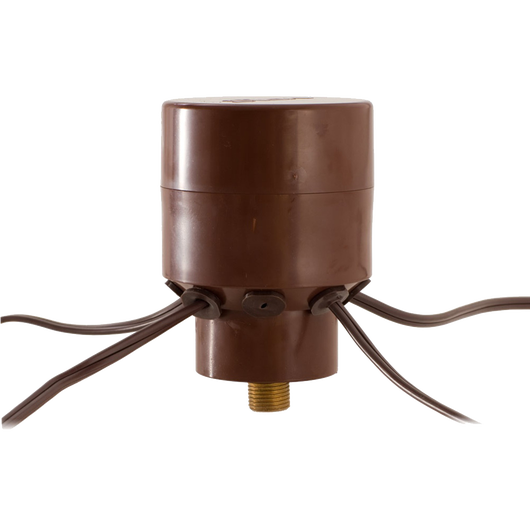Zone Control Junction Hub (Gen. I)
Connect multiple fixtures in the same zone in an above ground, water resistant junction box. One home run goes from the transformer to the junction box, then several cables leave the Junction Box and go to each individual fixture in that zone. Enables easy layouts, reduces cable usage, design better layouts for reducing voltage drop. To take the mystery out, our hub is simply an empty junction box -- a place to house multiple splice connections -- just like an irrigation box or electrical box.
In stock
VOLT® Zone Control Junction Box
Hubs are an easy, efficient way to ensure that you have done
your layout properly. They virtually guarantee perfect results,
bright even lighting, and prevents over/under volting. Additionally, all
your connections are in one place (so they are easy to trouble
shoot/service). Lastly, all your connections are above ground in a
dry, weather tight junction box – not in the ground exposed to
constant moisture and harsh electrical conditions like traditional
connections or even competing hub systems.
Hub System compatible fixtures have 25’ lead wires on them. You
place the hub in the middle of a distance zone; run a cable from
the transformer to the hub. Inside the hub connect all the fixtures
to the end of the cable. Do not cut the excess lead wire from the
fixtures—leave all fixtures with their original 25’ (this insures
that all fixtures have the same total amount of cable from the
fixture to the transformer. The end result is a home run with
several fixtures branching off the end of it like a flower stem
(home run) with multiple flower pedals (the fixture wires).
Electricity has to travel exactly equal distances from the
transformer to each fixture, plus there are no daisy chained
fixtures – perfect layout. Lastly, measure the voltage in any one
fixture (it will be the same for all of them on that hub). If the
voltage is below 12 volts, move that run up to the appropriate
voltage tap on the transformer until the fixtures have between
11-12 volts. For hub Systems you can use more fixtures per run, up
to 200 watts worth of fixtures.
To hub or not to hub, that is the question:
You don’t have to hub every fixture or only use hubs with “Hub
Compatible” fixtures with 25’ lead wires (although it
is certainly convenient). Hubs can make a great junction box for
spider splicing several main cables together (10-2 or 12-2 cables).
Many direct burial connectors can’t handle several thick gauge
cables connecting together – hubs make for a convenient, dry, above
ground place to make these connections. When doing more than a T
connection but a spider splice with several cables in one
place—hubs are great. Many fixtures in one area – hubs are
great.
Realistically most installs call for a combination of layout
methods—most fixtures hub connected, some far away fixtures that
are not grouped together will have the cable run “T” –d off to
reach them with a couple of daisy chained in line off the T. Some T’s
will be connected with a regular direct burial splice because there
are only 3 wires in a T. Another run may have 4 or 5 cables coming
off the home run more like a flow, and thus have the home run
hooked to a hub. Lastly many might have the fixtures wires
connected to the cable home run via a hub as a hub system is
traditionally used. No layout or property is the same, and you will
have to use a variety of techniques. The end goal is to be a champ
and get all your fixtures to output between 11.25-11.75 volts for
perfection!
PRO-TIP: ATTACH A SURFACE MOUNT ACCESSORY (INSTEAD OF A STAKE) AND
YOU CAN MOUNT THE HUB WHERE EVER YOU NEED IT -- INCLUDING IN TREES
WHEN DOING MULTIPLE FIXTURE DOWNLIGHTING, BEHIND RAFTERS WHEN
LIGHTING A PERGOLA, UNDER A DECK, ETC.. IT'S THE INDUSTRY'S ONLY
HUB THAT CAN ALSO BE SURFACE MOUNTED!
Features & Benefits:
- Note: Connectors NOT included. If you want them, you must order the splice connectors from the drop-down menu.
- Connections are inside a sealed compartment. Other manufacturers use an open design with connections underground and exposed to dirt/water/humid conditions and insects.
- Sealed body
- Removable top
- 8 rubber cap sealed cable entrance/exit holes
- Brass threaded spike screws
- Stake included
- Mount on a stake above ground for easy access or bury without a stake only exposing the top when discreet mounting is desirable.
- The "Zone Control" Junction box is a must for most landscape light layouts.
- Have one cable from transformer to the "Zone Control" Junction Box, then several cables coming out of the hub that goes to different fixture areas.
- As common sense would tell you, a junction box is a place to make all your splices instead of having to make separate home runs all the way back to the transformer. As with any electrical layout, you can wire in series or parallel. A hub enables you to wire in parallel thus reducing the voltage drop you get when wiring low voltage in series.
- Having a junction box out in an area reduces the need for many long runs back to the transformer, reduce cable usage, and provide more efficient, flexible layouts.
- Most importantly enables you to properly reduce voltage drop.
- Lifetime Warranty
| Specifications | Materials
Certifications
|
|---|

